- Enzymes are biological catalysts that speed up metabolic reactions inside the body.
Watch the Video at the End of This Blog to Unlock the Secrets of Enzymes ↓
We have heard of little things called “enzymes” inside our bodies, but what exactly are they and what do they do inside living bodies? This is what will be covered in today’s article, with a deep-dive into the mechanisms behind enzymes, substrates and products as well.
What are enzymes?
The simplest definition of an enzyme would be:
Enzymes are proteins that function as a biological catalyst.
Reading through this definition might put us in more confusion because it talks about a “catalyst”. What is therefore, a “catalyst”? A catalyst is defined as ‘something/ substance that increases the rate of a chemical reaction without being used up’.
We will use the aid of a diagram to simplify this explanation of what enzymes are:
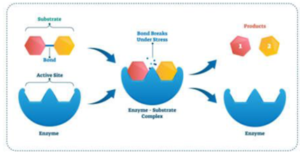
This diagram depicts an enzyme that is acting as a catalyst. We found out earlier that a catalyst is a substance that speeds up a chemical reaction. The molecule that is given here is referred to as the substrate, and the blue molecule shown in this diagram is the enzyme. The reaction depicts how this large molecule (with the pink part and the yellow part joined together) needs to be broken down into two parts, separated and split up. That is the reaction facilitated by this enzyme; the large molecule needs to break down into these two smaller molecules.
Reactions, where an enzyme breaks up a larger molecule into smaller molecules, are known as hydrolysis reactions.
Enzymes also join together smaller molecules and produce larger molecules by forming bonds between the smaller molecules. This reaction type is known as a dehydration reaction.
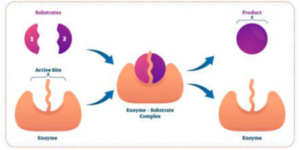
An enzyme is a biological catalyst, and a catalyst is a substance that speeds up a chemical reaction. This means that a catalyst increases the rate of a reaction.
When looking at the substrate molecules in both the diagrams given above, we can see that they change. In the first diagram, we start with a large molecule with the two parts linked up and then after the reaction we end up with two different molecules or two different products. In the second diagram, we start off with two separate smaller substrates but end up with one larger molecule or product.
Therefore, we can see that the substrate changes during the course of the reaction. However, before the reaction and even after the reaction, we can notice that the catalyst remains unchanged; the structure and shape of the catalyst is the same before and after the reaction, which means that catalysts do not undergo any changes during the course of the reaction.
That is, therefore, what we refer to as a catalyst.
Enzymes as catalysts
Enzymes are the catalysts inside our body. These enzymes are made up of protein molecules and they function as biological catalysts. If we consider the inside of our body, there are hundreds and hundreds of chemical reactions taking place, and these are known as metabolic reactions. Enzymes, therefore, while functioning as biological catalysts, speed up the chemical reactions taking place in our body. After the conclusion of all these metabolic/ biological reactions, enzymes remain chemically unchanged.
If we were to recap what we have learnt so far:
1. Enzymes are made up of proteins
2. They act as catalysts and speed up the chemical reactions in our body
3. These enzymes remain unchanged even after the reaction has been completed
Lock and Key Hypothesis
The lock and key hypothesis is a hypothesis on how enzymes work. Since this hypothesis appears to have something to do with a ‘lock’ and a ‘key’, let us consider this concept by using the diagrams shown below.
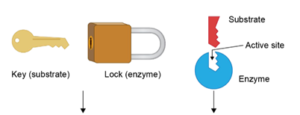
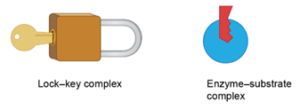
As per this hypothesis and in general, a particular lock will have one specific key, so this lock and this key are specific to each other. The lock can only be opened with a specific key and that specific key will only open one lock.
If we consider this in the context of enzymes, they also work quite similarly to a lock and a key.
In enzymes, there is a part of the enzyme called the active site, and this active site of an enzyme has a very specific shape and it is made in such a way that there is one substrate type that can attach to it. So one enzyme can fit only one substrate into this active site.
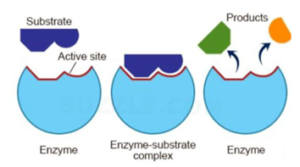
Therefore, just like the way the lock and the key are very specific to each other, the enzyme and the substrate have complementary shapes and they too are very specific to each other.
What is the active site of an enzyme?
The active site of an enzyme is the part of the enzyme that holds on to the substrate. The substrate is the substance the enzyme will work on. Enzymes have a very specific and unique three dimensional (3D) shape. Therefore, each active site is complementary to a specific substrate. Only one enzyme works on one substrate type and this is called substrate specificity.
How do enzymes speed up the chemical reactions in our body?
We learnt that enzymes speed up the chemical reactions in our body. They do this by lowering the activation energy needed to start the reaction.
The activation energy is the energy that is needed for a reaction to start. The more activation energy required, the slower the reaction rate will be. Enzymes work by lowering this activation energy needed for a reaction to start and thereby increases the rate of the reaction.
If we once again refer to the picture below, we can see that the substrate and the active site have complementary shapes.

This means that this substrate can come and bind to the active site, and by binding to the active site, the enzyme and substrate form an enzyme-substrate complex.

Thereafter the enzyme catalyzes the reaction and converts the substrate into the relevant products while the enzyme itself remains unchanged.

Another important point to note when discussing enzymes is that enzymes are required in very small amounts. However, we learnt that there are hundreds and hundreds of metabolic reactions taking place inside our body. This then brings us to the question, if so many reactions are taking place inside our body, why do we only need enzymes in extremely small quantities?
The reason is because we know that the substrate molecule comes and binds to an enzyme and then once the enzyme catalyses the reaction and forms the product, the enzyme is free to catalyze another reaction. This means that one enzyme molecule can catalyse a large number of reactions.
An example of this would be a spoonful of washing powder. Washing powder contains enzymes that break down stains, etc. A small amount like a spoonful of washing powder is enough to wash a large number of clothes clean. This is therefore the concept for any enzyme inside or outside the body. Just a minute amount is sufficient to catalyse a large number of reactions. The primary reason for this is because the enzyme remains unchanged after the reaction and that one enzyme is free to catalyse the same reaction over and over again.
Denaturation of enzymes
We have learnt that the active site of an enzyme is complementary to a specific substrate, as seen in the diagram below. As the substrate and the active site have complementary shapes, the substrate can easily come and bind to the active site.
In some cases, however, there are certain conditions which make an enzyme change its shape. Once the shape of the enzyme has been altered, or more specifically, once the shape of the active site has been altered, it is no longer possible for this substrate molecule to come and bind to the enzyme. This will lead the enzyme to be unable to catalyse the reaction.
The process by which the shape of enzymes is altered due to certain conditions is referred to as “denaturation”.
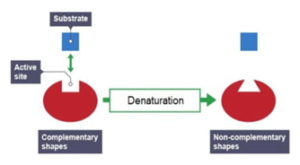
An enzyme can be denatured by the environment. If there is a very high temperature or an extreme pH for example, these kinds of extreme conditions might cause an enzyme to denature and change its shape. This is because enzymes are made of proteins and proteins denature when subject to extreme conditions. Therefore, if at the exam the question focuses on what denaturation is, it can be defined as when the enzyme’s shape is changed and the active site is no longer specific to the substrate.
Revising the Secrets of Enzymes: The Intricate Lock and Key Mechanism
Enzymes play an extremely important part in the lives of living organisms and catalyse many reactions. This topic is also frequently questioned in the exam papers.
Some questions on the secrets of enzymes can be found here as well, and you can time your answers to see if you can complete the quiz within the time limit.
If you are struggling with IGCSE revision or Biology in particular, you can reach out to us at Tutopiya to join revision sessions or find yourself the right tutor.
Attempt the quiz to know where you stand!



